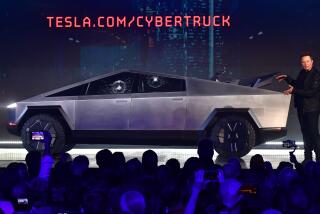Probe of Chevrolet Volt fires ends; safety regulators OK GM’s fix
Federal safety regulators have given the Chevrolet Volt an all-clear.
The National Highway Traffic Safety Administration said Friday that it did not identify a safety defect, concluding that the car does not pose any unusual risk of fire.
In closing the book on its investigation into Volts catching on fire, NHTSA also issued new guidelines for how emergency personnel and tow truck operators should deal with electric vehicles and plug-in hybrids that have been damaged in severe accidents.
The agency said it “remains unaware of any real-world crashes that have resulted in a battery-related fire involving the Chevy Volt or any other electric vehicle. NHTSA continues to believe that electric vehicles show great promise as a safe and fuel-efficient option for American drivers.”
NHTSA said it does not believe that Volts or similar vehicles pose a greater risk of fire than gasoline-powered autos.
The agency’s comments “are consistent with what we have said all along: The Volt and the electric cars are safe,” said Rob Peterson, a Chevrolet spokesman.
General Motors Co. is making modifications to the Volt because of a series of fires after test crashes of the plug-in hybrid vehicle. The fires were caused by a coolant leak that occurred when the car’s battery pack was punctured during severe side test crashes by NHTSA.
The fires occurred hours to weeks after the tests as the coolant leaked and eventually created a short circuit.
“We are learning about this technology as we go. NHTSA needs to be proactive in establishing these guidelines,” said Jeremy Anwyl, vice chairman of auto information company Edmunds.com.
In its guidelines, the safety agency said repair shops and salvage yards should not store a severely damaged vehicle with a lithium-ion battery — the type of battery in the Volt and many other vehicles that can operate on electricity — inside a structure or within 50 feet of any structure or other vehicle.
Storage yards should also contact the manufacture to have the battery drained of electricity.
And all safety and repair personnel should exercise caution and call the fire department if they detect leaking fluids, sparks, smoke, flames, increased temperature or gurgling from a damaged vehicle.
The guidelines are important because many similar vehicles are coming onto the market this year.
Ford Motor Co. plans to start selling an all-electric Focus and offer a plug-in hybrid version of the larger Fusion. Toyota Motor Corp. has a Prius plug-in, and Honda Motor Co. plans a plug-in version of the Honda Accord. Tesla Motors Inc. has its all-electric Model S sedan.
GM is retrofitting the roughly 8,000 Volts it has already sold and modifying new cars coming off the assembly line. It is adding structural reinforcement that better protects the battery pack from punctures or a coolant leak in a severe side crash.
NHTSA has conducted tests on Volts retrofitted with the structural reinforcement and said the remedy prevents the types of fires that were occurring in its early side-impact tests.
“There will be growing pains as this technology comes on the market. This won’t be the last thing that we hear of,” said Aaron Bragman, an analyst with IHS Automotive.
“GM came out with a fix for it because it was a public relations issue, but from an engineering viewpoint there really wasn’t a problem with the car, considering the conditions of the test needed to create a fire,” Bragman said.
Sales of electric vehicles and plug-in hybrids such as the Volt, which run on a combination of battery and gasoline power, were just a tiny segment of the U.S. market last year. Nissan Motor Co.’s Leaf, an all-electric vehicle, sold 9,674 units, and Chevrolet sold 7,671 Volts.
The Volt may get a boost in March, when a special edition that GM is producing for the California market will hit dealer showrooms. This version will come with a “low-emissions package” that is expected to qualify the vehicle for a $1,500 state rebate and access to California carpool lanes.
The lack of a state rebate and carpool lane sticker has hurt Volt sales in the state compared with Nissan’s Leaf, which has been its primary competitor among early adopters of electric and plug-in cars.
More than 60% of the Leafs sold were sold in California, in part because they qualified for the carpool lane permit and a state rebate. About 30% of the Volts sold so far have gone to California residents.







